Launching #Readalongs: Audio stories that make language acquisition more fun
Posted by Remya Padmadas on September 05, 2018This Teachers’ Day, StoryWeaver is pleased to announce the launch of a delightful set of audio stories for children, called Readalongs. Artfully narrated, and subtitled, these Readalongs bring stories alive in an engaging audio-visual form that will help children fall in love with reading.
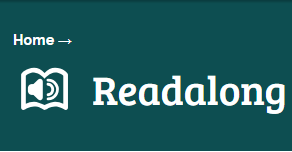
StoryWeaver has always strived to collaborate with the educator community to find more, and increasingly better, ways to introduce children to the joy of reading. Our Readalongs are the latest addition to this offering and have been designed to be joyful experiences for the child, with enjoyable background music, and a ‘natural’ narrative voiced by professional artists. Parallelly, same language subtitling, or SLS, provides synchronised highlighted text that urges the child to “read along” with the narrator’s voice.
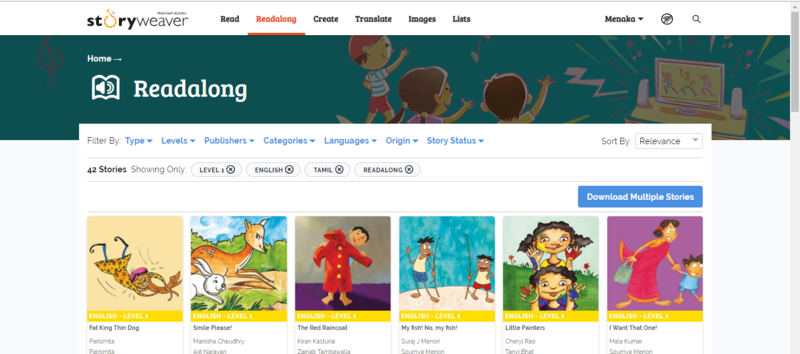
Suzanne Singh, Chairperson, Pratham Books, says, “Through StoryWeaver’s Readalong series of storybooks, we hope to introduce more children to the joy of reading and help them build their language acquisition skills through a combination of listening to the story and matching it to the supporting text.”
The Readalongs are aimed at the youngest of readers so a majority of the stories belong to Reading Levels 1 and 2, and are no more than 5 minutes long. Stories with repeat sounds and words, that are enjoyable to read aloud, as well as those with eye-catching illustrations, and a fair amount of dramatic flair were chosen.
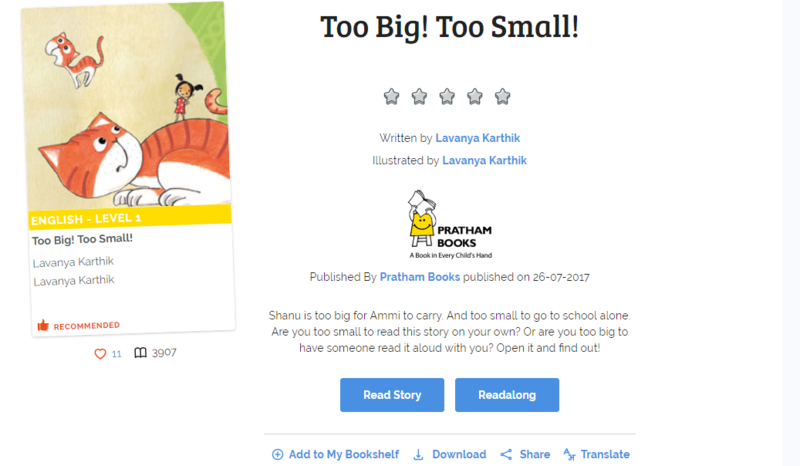
The Readalong series features English and Hindi stories for now, but will be expanded to include a wider range of languages once we gain user feedback on these.
Purvi Shah, Head of Digital Platforms, Pratham Books, adds, “StoryWeaver has consistently added features and tools born out of our interaction with educators and on-ground partners. The Offline Library, which allows access to the StoryWeaver experience even in the absence of internet coverage, is one such feature. Curated Lists, accompanied by classroom activities, is another. This Teachers’ Day, we’re happy to add a third -- Readalongs. Consider it our celebration of Teachers’ Day!”
comments (6)We did it: One million online reads on StoryWeaver!
Posted by Remya Padmadas on May 20, 2018A million! A great thousand! A thousand thousands! We found out that there was no word for million in Old English simply because its speakers had no great use for it! Well, we're glad that the word million was coined, because here we are, on the other side of #RaceToAMillionReads.
First of all, a big THANK YOU to our amazing community across the world for being such an integral part of what we do. It's your stories, your translations and your unwavering belief that all children should have access joyful stories that have helped us celebrate so many milestones. Without your support and goodwill we wouldn't be where we are or having so much fun doing what we do!
We hope you continue to support us on our journey to find more ways to provide equitable access to stories in mother tongue languages for all children.
See you at... two million? A billion? A trillion?
comments (4)ಮಿಂಗ್ ಮಿಂಗ್ ನ ಟೊಂಯ್ ಟೊಂಯ್ ಮತ್ತು ನಗುವಿನ ಗುಟ್ಟು
Posted by Remya Padmadas on December 02, 2019Pratham Books' in-house editor, Hema D Khurshapur, writes exclusively about translations and how they end up giving the feel of the original story, if given a fresh approach. In this blog post, she writes about C.P. Ravikumar's translation of Ming-Ming, Fat Little Bear’s translation into Kannada and the psychology behind laughter.
ಮನುಷ್ಯರ ಮಕ್ಕಳಿಗಷ್ಟೇ ತುಂಟತನ ಸೀಮಿತವೇ? ಪ್ರಾಣಿಗಳ ಮಕ್ಕಳೂ ತುಂಟತನ ಮಾಡಬಹುದಲ್ಲವೇ? ಅದ ರಲ್ಲೂ ಮುದ್ದಿಗೆ ಹೆಸರಾದ ಕರಡಿ ಮರಿಗಳು ತುಂಟತನ ಮಾಡಿದರೆ ಹೇಗಿರುತ್ತದೆ. ಅದೇ ಈ ಪದ್ಯದಲ್ಲಿ ಮೂಡಿ ಬಂದಿರುವುದು. ಕೂದಲಿಗೆ ಉದಾಹರಣೆ ಕೊಡುವಾಗ ನಾವೆಲ್ಲ ಒಂದಲ್ಲ ಒಂದು ಸಲ ಬಳಸಿರುವ ವಾಕ್ಯ, ಅಲ್ಲಿ ನೋಡು ಅವನ ಅಥವಾ ಅವಳ ಕೂದಲು ಕರಡಿ ಕೂದಲಂತೆ ಎನ್ನುವುದು.
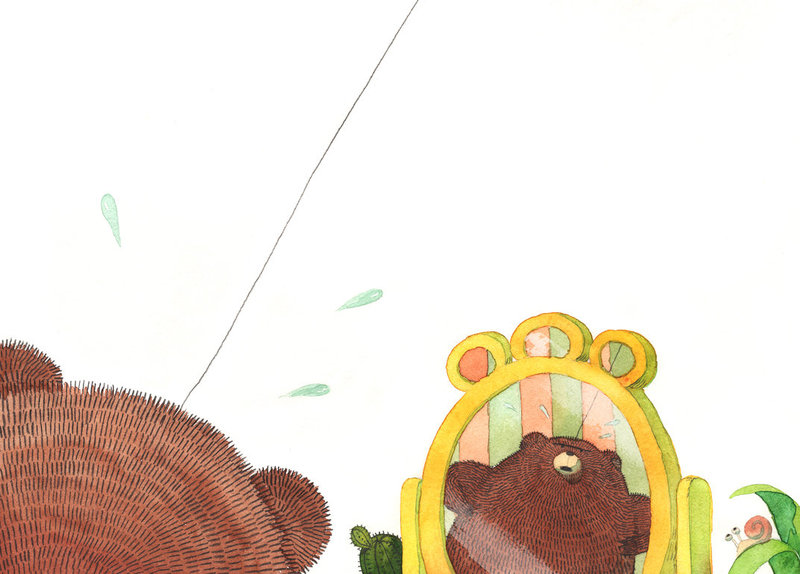
Illustrations from the book, Ming-Ming, Fat Little Bear, by Vishnu M Nair
ಕನ್ನಡದಲ್ಲಿ ಕರಡಿ ಮತ್ತು ಕರಡಿ ಮರಿ ಕುರಿತಾಗಿ ಬಹುತೇಕ ಮಕ್ಕಳು ಕೇಳಿರಬಹುದಾದ ಒಂದು ಕವನ, ಒಂದು ಕತೆ ಇದೆ. ಕವನ ಅಂದ್ರೆ ಅದು ಬೇಂದ್ರೆಯವರ ‘ಕರಡಿ ಕುಣಿತ’, ಕತೆ ‘ಜಾಂಬವಂತ’ ಕರಡಿಯ ಕತೆ. ‘ಕರಡಿ ಕುಣಿತ’ ಕವನ ಕರಡಿ ಆಡಿಸುವವನಿಂದ ಶುರುವಾಗಿ, ಮಕ್ಕಳು ಕರಡಿಯನ್ನು ಮುಟ್ಟಿ ನೋಡುವ ಪ್ರಕ್ರಿಯೆ ಮುಗಿದು, ಕರಡಿಯ ಕೂದೆಲೆಳೆ ಮಕ್ಕಳಿಗೆ ದೃಷ್ಟಿಯಾಗದಂತೆ ತಡೆಯುತ್ತದೆ ಎನ್ನುವ ನಂಬಿಕಯೊಂದಿಗೆ ಮುಗಿಯುತ್ತದೆ. ‘ಜಾಂಬವಂತ’ ಕರಡಿಯ ಕತೆಯಲ್ಲಿ ಬರುವ ಕರಡಿ ಮಾತ್ರ ಜೇನು, ಹಲಸಿನ ಹಣ್ಣು ತಿನ್ನುವ ಮುದ್ದು, ಮುದ್ದು ಪ್ರಾಣಿಯಾಗಿ ಮಕ್ಕಳನ್ನು ಸೆಳೆಯುತ್ತದೆ.
ಆದರೆ ಈ ಮಿಂಗ್ ಮಿಂಗ್ ಎಂಬ ಕರಡಿ ಮರಿ, ಇನ್ನೂ ಮುದ್ದು ಮುದ್ದು. ಒಂದು ದಿನ ಬೆಳಗಾಗಿ ಎದ್ದು ನೋಡಿದರೆ ಮರಿಯ ತಲೆಯ, ಮೈಮೇಲಿನ ಕೂದಲೆಲ್ಲ ನೆಟ್ಟಗೆ ನಿಂತಿವೆ. ಅದಕ್ಕೆ ಏನು ಮಾಡಬೇಕೋ ತೋಚುತ್ತಿಲ್ಲ. ಯಥಾ ಪ್ರಕಾರ ಅಪ್ಪ-ಅಮ್ಮ, ಅಣ್ಣ-ಅಕ್ಕ, ದೊಡ್ಡಪ್ಪ-ಚಿಕ್ಕಪ್ಪ ಎಲ್ಲರೂ ಒಂದೊಂದು ಸಲಹೆ ಕೊಡುವವರೇ. ಎಲ್ಲರ ಮಾತು ಕೇಳಿ ತಲೆ ಚಿಟ್ಟು ಹಿಡಿದು ಮಲಗುವ ಕರಡಿ ಮರಿಯ ಕೂದಲು ಮತ್ತೊಂದು ಬೆಳಗ್ಗೆ ಎದ್ದು ನೋಡುತ್ತಲೇ ಮೊದಲಿನಂತಾಗಿ ಬಿಟ್ಟಿರುತ್ತದೆ.
ಇಂಗ್ಲಿಷ್ ನಲ್ಲಿ ಎಲ್ಲವೂ ಸರಿ ಎನ್ನಿಸಿಯೇಬಹುದಾದ ಅಥವಾ ಹಾಗೆಂದು ನಾವು ಭಾವಿಸುವ ವಾಕ್ಯ ರಚನೆಗಳನ್ನು ಕನ್ನಡಕ್ಕೆ ತರುವಾಗ ಎದುರಾಗುವ ಸಮಸ್ಯೆಗಳು ಒಂದೆರಡೆಲ್ಲ. ಅದು ಅನುವಾದ ಪ್ರಕ್ರಿಯೆಯಲ್ಲಿ ತೊಡಗಿ ಕೊಂಡವರಿಗೆಲ್ಲ ಗೊತ್ತಿರುವ ವಿಷಯ. ಈ ಕವನವನ್ನು ಕೂಡ ಇಂಗ್ಲಿಷಿನಲ್ಲಿ ಓದುವಾಗ ಚೆಂದ ಎನಿಸುವ ಪ್ರಾಸಗಳನ್ನು ಕನ್ನಡಕ್ಕೆ ತರುವುದು ನಿಜಕ್ಕೂ ಸ್ವಲ್ಪ ಕಷ್ಟದ ಕೆಲಸ. ಕವನ ವನ್ನು ಟ್ರಾನ್ಸ್ ಫಾರ್ಮ್ ಮಾಡದೇ ಅನುವಾದದಲ್ಲಿ ಸ್ವಲ್ಪ ಮಟ್ಟಿನ ಸ್ವಾತಂತ್ರ್ಯ ವಹಿಸಿ ಒಂದೆರೆಡು ವಾಕ್ಯ, ಒಂದೆರೆಡು ಸಾಲುಗಳನ್ನು ಸೇರಿಸುವ ಮೂಲಕ ಕವನವನ್ನ ಕನ್ನಡದ್ದೇ ಆಗಿಸಿದ್ದು ಅನುವಾದದ ಮಟ್ಟಿಗೆ ಒಳ್ಳೆಯ ಪ್ರಯತ್ನ. ಓದುತ್ತಿದ್ದರೆ ನಗುವನ್ನು ತಡೆಯಲು ಆಗದ ಕೆಲಸ. ಇಂತಹ ಒಳ್ಳೆ ಪ್ರಯತ್ನಕ್ಕಾಗಿ ಅನುವಾದಕ ಸಿ.ಪಿ.ರವಿಕುಮಾರ್ ಅವರಿಗೆ ಅಭಿನಂದನೆಗಳು.
ಬರೀ ಮಿಂಗ್ ಮಿಂಗ್ ಎಂಬ ಮುದ್ದು ಕರಡಿ ಮರಿ ಪದ್ಯ ಕನ್ನಡಕ್ಕೆ ಅನುವಾದಗೊಂಡ ಪ್ರಕ್ರಿಯೆ ಚೆಂದವಾದದ್ದು ಅಂತ ಓದಿದರೆ ಸಾಕೇ... ಓದುವಾಗ ಬರುವ ನಗು, ಹುಟ್ಟುವುದು ಹೇಗೆ ಎನ್ನುವುದರ ಬಗ್ಗೆಯೂ ಒಂದು ಕುತೂಹಲವಾದ ವಿಷಯವಿದೆ.
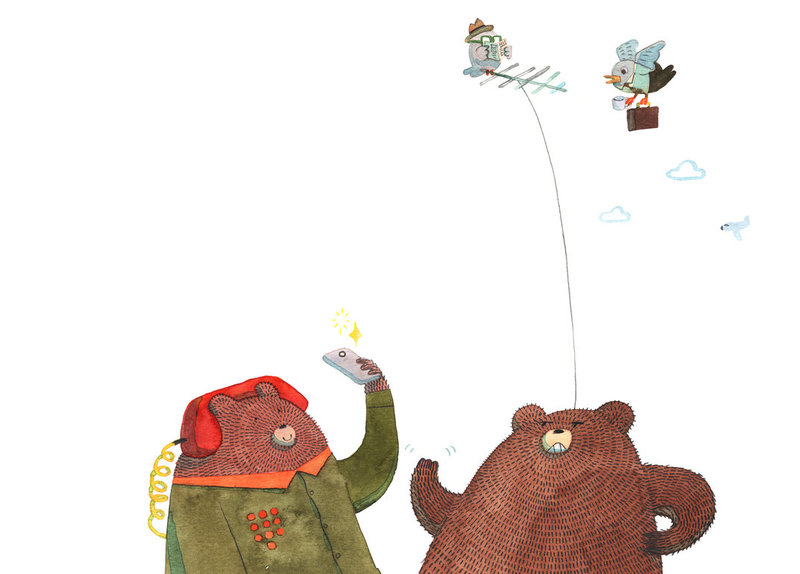
Illustrations from the book, Ming-Ming, Fat Little Bear, by Vishnu M Nair
ನಗು ಹುಟ್ಟುವುದು ಹೇಗೆ?
ಪ್ರಶ್ನೆಗೆ ಉತ್ತರ ತುಂಬಾ ಸರಳ. ಒಬ್ಬ ಹಾಸ್ಯನಟನನ್ನು ನೋಡಿದರೆ ಸಾಕು, ನಮಗೆ ತಿಳಿಯುತ್ತದೆ! ಆದರೆ ನಗೆ ಸಂಕೀರ್ಣ ವಿಷಯ. ನಾವು ಸಹಜವಾಗಿ ಭಾವನೆಗಳನ್ನು ಅಭಿವ್ಯಕ್ತಿಸುತ್ತೇವೆ. ನಗು ಮನುಷ್ಯರ ನಡುವೆ ಮಾತ್ರ ಕಂಡು ಬರುತ್ತದೆ. ಆದರೆ, ಮನಃಶಾಸ್ತ್ರಜ್ಞರು ನಗುವಿನ ಬಗ್ಗೆ ಎರಡು ಮೂಲಭೂತ ಪ್ರಶ್ನೆಗಳನ್ನು ಇನ್ನೂ ಅಧ್ಯಯನ ಮಾಡುತ್ತಿದ್ದಾರೆ. ಒಂದು, ಜನರನ್ನು ನಗುವಂತೆ ಮಾಡುವುದು ಯಾವುದು? ಎರಡು, ನಗುವಿನ ಉದ್ದೇಶವೇನು? ಜನರು ನಗುವಂತೆ ಮಾಡುವ ಅಂಶ ಯಾವುದು ಅಥವಾ ಜನ ಯಾವುದನ್ನು ತಮಾಷೆ ಎಂದು ಪರಿಗಣಿಸುತ್ತಾರೆ ಎಂದು. ಉತ್ತರ ಹುಡುಕುತ್ತಾ, ಆಲೋಚಿಸುತ್ತಾ ಹೋದರೆ ನಾವು ಮನಃಶಾಸ್ತ್ರಜ್ಞ ಅಥವಾ ತತ್ವಜ್ಞಾನಿಗಳಾಗಿ ಬಿಡುತ್ತೇವೋ ಏನೋ?
ಜನರ ಕೆಲವು ಎಡವಟ್ಟು, ವ್ಯಕ್ತಿಯ ದೌರ್ಬಲ್ಯ ಅಥವಾ ಕುಂದು-ಕೊರತೆ, ಕಾಳಜಿಯ ಸಂದರ್ಭಗಳಲ್ಲೂ ಜನರು ನಗುತ್ತಾರೆ. ನಗುವಿನ ಬಗೆಗಿನ ಮತ್ತೊಂದು ವಿವರಣೆ ಎಂದರೆ, ಇದ್ದಕ್ಕಿದ್ದಂತೆ ನೋಡಿದ ಕೆಲವು ದೃಶ್ಯಗಳು ನಗು ಹುಟ್ಟಿಸುತ್ತವೆ. ಅವು ಸಹಜ ಸಂಗತಿಗಳೇ ಇರಬಹುದು ಅಥವಾ ವ್ಯಕ್ತಿಗಳು ಜತೆಗಿದ್ದಾಗ ಕಣ್ಣ ಮುಂದೆ ನಡೆಯುವ ವಿಷಯಗಳಿರಬಹುದು. ಎಲ್ಲ ರೀತಿಯ ನಗುವಿಗೂ ಈ ಸಿದ್ಧಾಂತ ಅನ್ವಯವಾಗುವುದಿಲ್ಲ. ಕಾಮಿಕ್ ನೋಡಿದಾಗ ಉಕ್ಕುವ ನಗುವೇ ಬೇರೆ, ವಿನೋದ ಸಾಹಿತ್ಯ ಅಥವಾ ಘಟನೆ ನೋಡಿದಾಗ ಉಂಟಾಗುವ ನಗುವೇ ಬೇರೆ. ದೈಹಿಕವಾಗಿ ನಗುವಿನ ಅಂಶವನ್ನು ನೋಡಿದರೆ, ನಗು ಒಳ್ಳೆಯದು. ಇದು ನಮ್ಮ ಶ್ವಾಸಕೋಶಕ್ಕೆ ಮತ್ತು ದೇಹಕ್ಕೆ ಬೇಕಾದ ಹೆಚ್ಚುವರಿ ಶಕ್ತಿಯನ್ನು ಒದಗಿಸುತ್ತದೆ. ನಾವು ಸಾಮಾನ್ಯವಾಗಿ ಹೆಚ್ಚು ನಗುವುದು ಒಂದು ಗುಂಪಿನಲ್ಲಿದ್ದಾಗ. ಈ ಸಿದ್ಧಾಂತದ ಪ್ರಕಾರ ಜನರ ನಗುವನ್ನು ನೋಡಿ ಅವರ ವರ್ತನೆಯ ಟಿಪ್ಪಣಿ ಮಾಡಬಹುದಂತೆ!!
Do leave your thoughts in the comments section below. You can also reach out to us through our social media channels: Facebook, Twitter and Instagram.
Be the first to comment.